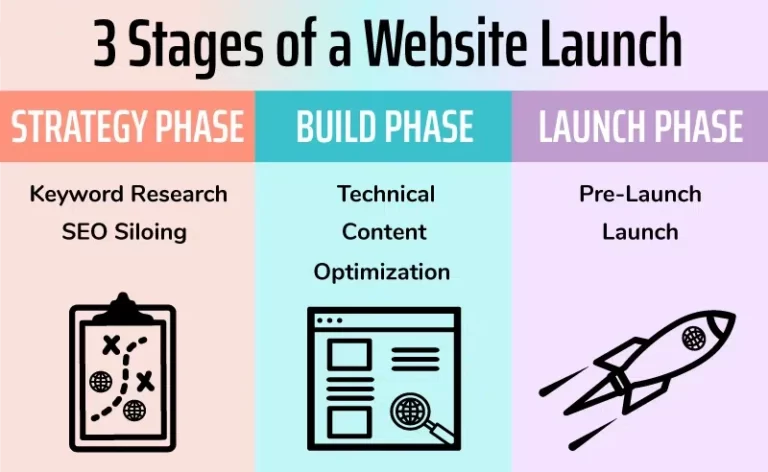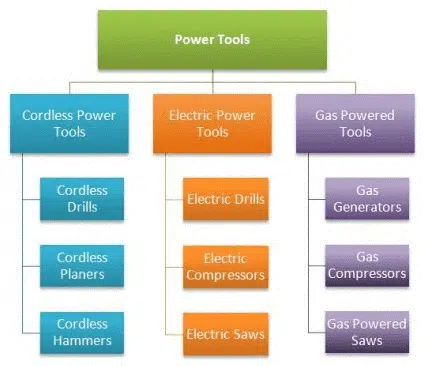The process of launching a new website transcends mere design and content. It entails the seamless integration of SEO at every juncture, spanning from the initial strategy phase to the ultimate launch.
- The Strategic Phase
- The Development Phase
- The Launch Phase

Phase 1: The Strategic Phase
Keyword Research
- What are the primary topics that our website should cover?
- If you were searching for our products or services on a search engine, what keywords would you use?
- How does our audience typically describe what we offer?
- What problems do our products or services solve, and what keywords might people use when searching for solutions to these problems?
SEO Siloing
- Facilitating user navigation by structuring the website logically.
- Enhancing the website’s relevance for important keywords, thereby improving page rankings.
- Establishing your website’s authority and expertise within a specific subject area.
Leveraging your keyword research, you can create a site architecture that seamlessly integrates these keywords into the content. To illustrate, consider a fictional power tools website that offers cordless power tools, electric power tools, and gas-powered tools. Your keyword research might reveal key terms such as “cordless power tools,” “electric power tools,” and “gas-powered tools,” among others.
As an active participant in the website’s design and development process (which you should be), you can demonstrate how the site navigation and content will align with and support these keywords. The graphic below illustrates the landing pages and subpages for the power tools website, each containing content that reinforces the primary keywords.

Phase 2: The Development Phase
1. Technical Aspects
Before commencing their work, it’s vital to engage in discussions to guarantee that the website is:
- Easily accessible and crawlable for search engines.
- Accessible across various devices for a seamless user experience.
- Equipped with webpages that facilitate user interactions, including links, buttons, and pop-ups.
- Fast and secure.
- Clean and efficient code.
- Swift page loading.
- Mobile responsiveness.
- Compliance with core web vitals.
- Avoidance of intrusive pop-ups.
- Implementation of HTTPS for enhanced security.
Google offers valuable insights on these topics through its Google for Developers resources.
2. Content Development
- Does the content possess the requisite expertise and experience on the topic?
- Is your website or brand positioning itself as an authority within the niche?
- Can visitors trust the information provided?
- Does your content surpass competitors in answering user queries?
- Are you incorporating data from search results, such as “People Also Ask” and “Searches related to,” in addition to addressing common FAQs?
- Does your content include original research, data, opinions, and relevant images?
- Are you diligently fact-checking and citing high-quality, pertinent sources?
- Are you maintaining a high level of accuracy, especially for topics falling under “Your Money or Your Life” categories?
For further guidance, refer to Google’s:
- Search Quality Rater Guidelines.
- Resources on creating helpful, user-centric content.
- In-depth strategies for navigating Google core updates.
3. Optimization
Once the pages are constructed, and the content is integrated, the subsequent step entails optimizing each page to the best of your ability. While there isn’t a one-size-fits-all checklist for optimization, several key on-page tactics warrant consideration:
- Readability: Assess whether your content aligns with the appropriate grade level for the intended audience and subject matter.
- Meta Tags: Verify that each webpage boasts unique, compelling title tags and meta descriptions within the recommended character limits, while also incorporating relevant keywords.
- Heading Tags: Confirm that heading tags on webpages adhere to proper formatting and hierarchy (H1, H2, H3, H4, etc.).
- Keyword Optimization: Explore opportunities to enhance page relevance through strategic keyword placement.
- Image Optimization: Optimize images to increase the chances of attracting traffic through image search results.
- Alt Text: Ensure the inclusion of alt text for images to accommodate visually impaired users.
- Schema Markup: Leverage schema.org and other structured data to clarify page content for search engines and enhance search engine result listings.
- Other Structured Data: Format pages to enhance content comprehension for both search engines and users (e.g., tables of contents, tables, bulleted lists, etc.).
- Links: Evaluate the use of fully qualified links, as absolute links may require more upfront work but offer easier long-term maintenance.
By diligently addressing these technical, content, and optimization considerations during the development phase, you pave the way for a website that not only looks appealing but also excels in terms of SEO performance. This ensures that your website will be well-prepared for the final launch phase and beyond.
Phase 3: The Launch Phase
Pre-launch:
Before your website goes live, there are essential preparatory tasks to tackle:
- Accessibility: Employ an SEO tool to conduct a comprehensive website crawl to identify and rectify any errors or accessibility issues.
- Analytics: Ensure that your Google Analytics and Google Search Console are correctly configured to accurately monitor and analyze website traffic and performance.
- Technical Optimization: Verify that critical technical elements such as the XML sitemap, HTML site map, and robots.txt file are configured correctly to facilitate smooth website operation.
Launch:
The launch day marks an exhilarating time for all stakeholders. From an SEO perspective, this phase revolves around vigilant monitoring and responsive action. Keep a watchful eye on the following aspects:
- Technical Errors: Utilize SEO tools to monitor the website for any technical glitches or errors that might crop up during or after the launch.
- Indexing: Understand that it may take several days or even weeks for search engines to fully index your website. Nonetheless, stay vigilant for any unexpected indexing issues that may arise.
As long as competition exists, and as long as Google and other search engines refine their algorithms, maintaining an SEO strategy for your website remains imperative.
Starting strong with your new website:
In an era of heightened competition within search results, embedding SEO principles into your website from its inception provides a competitive advantage. This approach positions you better for success.
The sooner you initiate efforts to drive traffic, the more advantageous it becomes. Each day is consequential as you endeavor to outpace your competitors in the dynamic digital landscape.
Contact us and one of our experts will help with more info.

